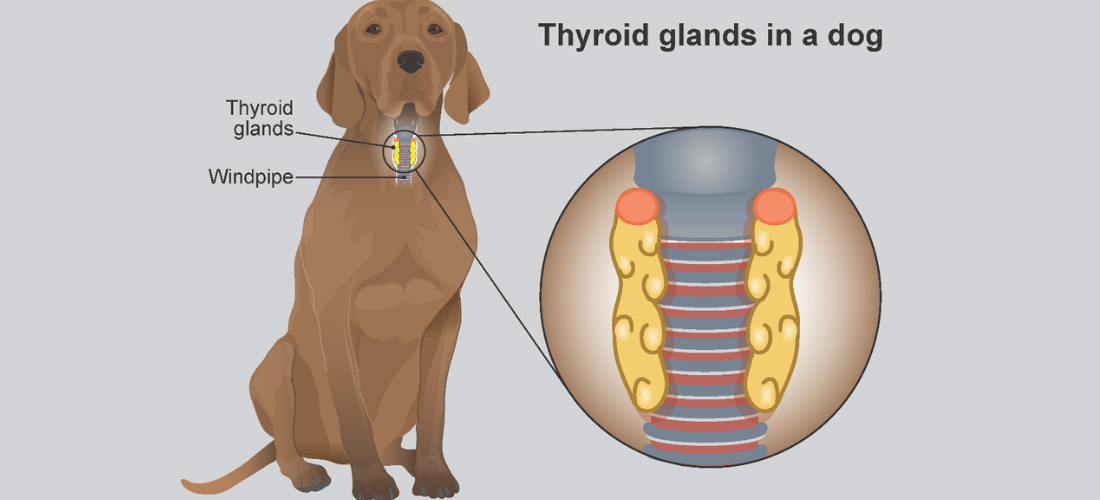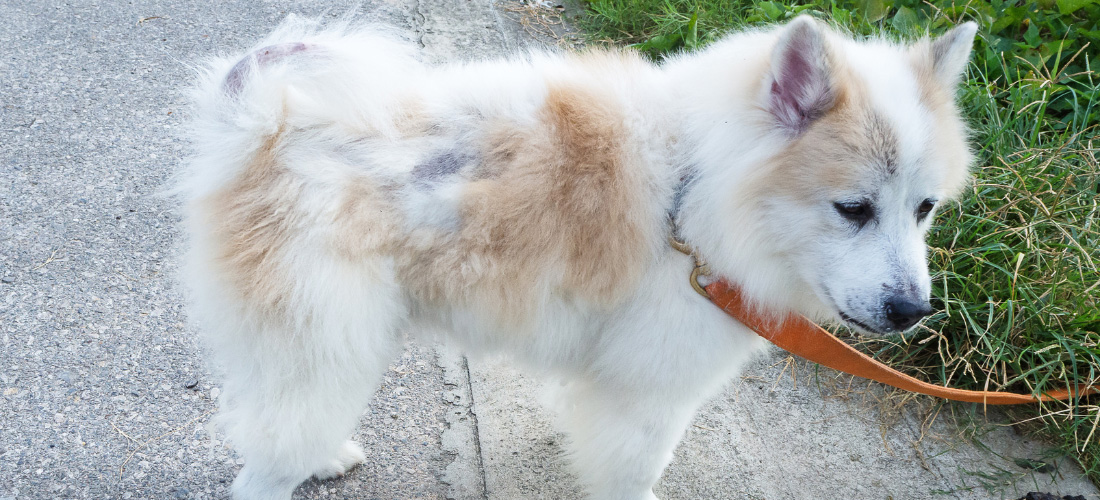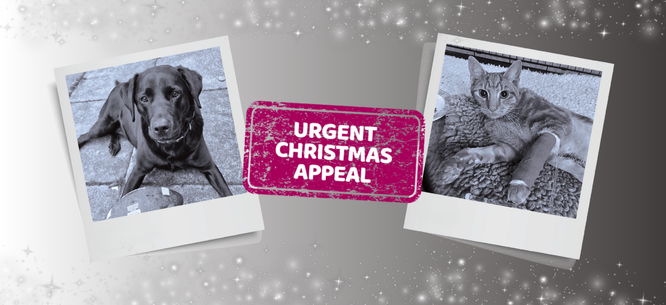Hypothyroidism in dogs
Overview
- Hypothyroidism is a lack of thyroid hormones due to underactive thyroid glands.
- Symptoms of hypothyroidism include weight gain, low energy, and alopecia (fur loss).
- Hypothyroidism is treated using daily medication to replace the missing thyroid hormones.
- With treatment, the outlook for a dog with hypothyroidism is excellent.
- Contact your vet if your dog is showing signs of hypothyroidism.

The thyroid glands are two small glands that sit in the throat, next to the windpipe. They produce thyroid hormones, which play a crucial role in regulating the body’s metabolism. Hypothyroidism is when the thyroid glands don’t produce enough thyroid hormones.
What causes hypothyroidism in dogs?
Hypothyroidism in dogs can be caused by several different things, including:
- Immune mediated destruction: This is when the dog's immune system mistakenly attacks and damages the thyroid gland, leading to reduced thyroid hormone production. This is by far the most common cause of hypothyroidism in adult dogs, and tends to develop gradually over a period of months to years. You may also hear this type of hypothyroidism called ‘autoimmune thyroiditis’ or ‘lymphocytic thyroiditis’.
- Idiopathic thyroid atrophy: This is also a very common cause of hypothyroidism in dogs. It’s when the thyroid gland shrinks or deteriorates, and as a result, stops producing thyroid hormone. Vets aren’t exactly sure why idiopathic thyroid atrophy occurs – more research is needed in this area.
- Congenital Hypothyroidism: In rare cases, dogs can be born with a thyroid gland that doesn't function properly from birth. This is a genetic condition.
- Medications: Some medications, like certain antibiotics, steroids, anti-epileptics, NSAID’s and diuretics can interfere with thyroid function, causing hypothyroidism.
- Tumours: Thyroid tumours can disrupt the thyroid’s normal function, leading to reduced hormone production. Fortunately thyroid tumours are rare.
- Radiation therapy: Although it’s rare, dogs receiving radiation treatment for other conditions, particularly in the neck region, may experience damage to the thyroid gland, leading to hypothyroidism.
It’s important to note that although all the causes in this list are all possible, immune mediated destruction is by far the most common cause of hypothyroidism in dogs. Any breed can be affected, but some breeds are at a higher risk of developing it for example Tibetan Terriers, Dobermanns and, Boxers.
Symptoms of hypothyroidism in dogs
Symptoms of hypothyroidism are usually vague and develop gradually – common signs include:
- Unexplained weight gain, or difficulty losing weight
- Alopecia (fur loss) – especially around the neck, sides, and tail
- Lethargy (low energy)
- Dandruff
- Skin and ear infections
- Thick skin around the face and a ‘sad’ expression
- Feeling cold - you may notice your dog shivering, or constantly seeking heat
- Coma (in severe cases)

This dog has fur loss on his sides and tail due to hypothyroidism.
Diagnosis
Hypothyroidism in dogs is diagnosed through a combination of symptoms, and blood tests. To begin with, your vet will want to rule out any other underlying problems, because other illnesses can cause a drop in thyroid levels, which can lead to a false diagnosis of hypothyroidism.
Even then, it’s very common to need multiple blood tests, and sometimes repeat tests a few months apart to be sure of a hypothyroidism diagnosis. Common blood tests for hypothyroidism include:
- Haematology and biochemistry: to check for common changes hypothyroidism can have on the rest of the body.
- Thyroid hormone levels: this will be low if your dog has hypothyroidism.
- TSH (Thyroid Stimulating Hormone) levels: this is usually (but not always) high if your dog has hypothyroidism.
Treatment
Fortunately, treating hypothyroidism in dogs is relatively simple. Most conditions can be well controlled with thyroid hormones - given as a tablet or liquid, once or twice a day. If your dog responds well to treatment, they will need to stay on their medication for the rest of their life.
 Video found at youtu.be/A4v4f1_s-xQ
Video found at youtu.be/A4v4f1_s-xQ
How long will treatment take to work?
- Your dog should seem happier and more energetic within a couple of weeks.
- They may lose more fur to begin with but it’s likely to start re-growing within 4-6 weeks.
- They should be looking much slimmer and healthier within 3 months, and be back to normal within 6 months.
Check-ups
- Your dog will need regular vet checks, and you will need to monitor for any new symptoms at home.
- Your vet may perform repeat blood tests to ensure your dog’s thyroid hormones are staying at the right level.
Cost
Treatment for hypothyroidism can become expensive, so it’s important to speak openly with your vet about the cost of treatment, your finances, and what you think is right for your dog.
Consider insuring your dog as soon as you get them, before any signs of illness start to ensure you have financial support to care for them.
- What happens if hypothyroidism is left untreated?
- What is the difference between ‘hypothyroidism’ and ‘hyperthyroidism’?
- What is the best dog food for hypothyroidism ?
What happens if hypothyroidism is left untreated?
If you leave your dog’s hypothyroidism untreated, they will continue feeling poorly and their symptoms will get worse. Eventually severe complications will develop which could lead to death.
What is the difference between ‘hypothyroidism’ and ‘hyperthyroidism’?
Hypothyroidism is the opposite of hyperthyroidism:
- Hypothyroidism = low levels of thyroid hormone (common in dogs, rare in cats).
- Hyperthyroidism = high levels of thyroid hormone (common in cats, rare in dogs).
What is the best dog food for hypothyroidism ?
Hypothyroidism nearly always causes weight gain in dogs. However, once your dog has started treatment, their metabolism will return to normal and they will lose those extra pounds. It’s unlikely you will need to change your dog’s diet.
Published: January 2024
Did you find this page useful?
Tell us more
Please note, our vets and nurses are unable to respond to questions via this form. If you are concerned about your pet’s health, please contact your vet directly.
Thank you for your feedback
Want to hear more about PDSA and get pet care tips from our vet experts?
Sign up to our e-newsletter
Written by vets and vet nurses. This advice is for UK pets only. Illustrations by Samantha Elmhurst.

